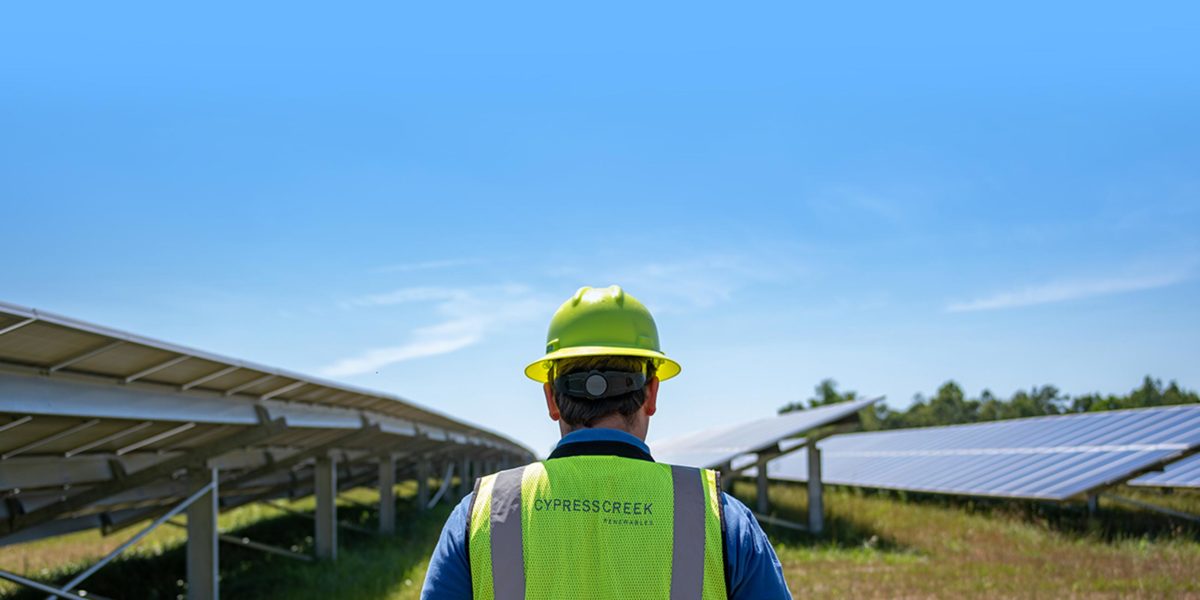If you work for Cypress Creek Renewables, are a pro-renewables Virginian or just a solar proponent in general, chances are you’re having a pretty good day. For those who don’t fit the above designations, this is because the Virginia Department of Environmental Quality (DEQ) and Governor Ralph Northam (D) have approved and issued permits for three solar projects totaling a tick under 213 MW in the state.
The approved projects are the Water Strider Solar, totaling 80 MW and located in Halifax County, the Powells Creek Farm Solar (70 MW), also located in Halifax County and the Sol Madison Solar, the baby of the bunch at 62.5 MW, which will call Orange County home.
The Water Strider and Sol Madison projects will be developed by Cypress Creek, while Carolina Solar is responsible for the Powells Creek Farm project.
The projects will generate enough electricity to power more than 25,000 homes. In the notably extensive detail that DEQ has shared, the three will combine to offset 345,598,101 pounds of carbon dioxide, 246,587 pounds of nitrogen oxides and 283,928 pounds of sulfur dioxide. Those are wildly specific numbers for that scope of size, but we’re glad to have them.
This now brings the total capacity of solar approved by DEQ in the last four years over 1 GW. Ever since the beginning of the Spotsylvania debacle, big solar has been moving into Virginia, with Dominion and sPower getting in on the party. In addition to the approved capacities, DEQ has received notices of intent for an additional 3.4 GW of proposed projects.
Virginia has been a battleground state for solar. Outside of the aforementioned hotly contested Spotsylvania project, the state has not been the most welcoming to solar. At the beginning of this year, HB 2329 was defeated. HB 2329, as analyzed by Ivy Main, the Renewable Energy Chair for the Virginia Chapter of the Sierra Club, would have:
- Removed the 1% cap on net metered solar
- Confirmed the legality of third-party financing through power purchase agreements (PPAs) for customer-sited solar
- Allowed local governments to install solar facilities of up to 5 MW on government-owned property and use the electricity for nearby government-owned buildings
- Allowed a customer to attribute the output of a single renewable energy facility to more than one meter on the customer’s property or on adjacent property owned by the same customer
- Removed restrictions on customers installing a net-metered solar facility larger than required to meet their previous 12 months’ demand
- Raised the project size cap for net-metered non-residential projects from 1 MW to 2 MW
- Removed the standby charges on residential solar facilities between 10 and 20 kW
While it’s disappointing that the bill failed, it’s unsurprising. What we’re seeing in Virginia is a state that’s coming around to the idea of solar development, but as the utilities dictate it. We’ve seen a similar situation in Arizona and while it’s nice that we see big utility development like the projects above, it comes at a cost. that cost is frequently the stunting of distributed solar.
However, Virginia does have one factor separating it from Arizona. Last year, in the 2018 Energy Plan, recommendations, for utility scale development were made:
Virginia’s investor-owned utilities should issue a Request for Proposals (RFP) for the development of solar and wind generation in the Commonwealth. The RFP should be issued annually beginning in 2018, and the RFP should include the procurement of at least 500 megawatts of solar or wind projects each year.
And, while this would again just be another sign of utility-scale development, a fun little tidbit followed that section. That tidbit read:
To achieve the goals set forth in Senate Bill 966, Dominion Energy should annually issue a Request for Proposals (RFP) beginning in the Spring of 2019 to procure 150 MW of rooftop solar installations annually, with at least 25% procured through power purchase agreements (PPAs).
Furthermore, it was suggested that the General Assembly raise the state’s 1% aggregate cap on the net metering program to 5% of each electric distribution company’s adjusted Virginia peak-load forecast for the previous year.
Now that 150 MW of rooftop procurement RFP is great, the net metering raise is just a suggestion. These are great policies, or at least they would be if they were policies, rather than plans and suggestions.
So, as we celebrate another crop of projects that hopefully reach completion in Virginia, it’s important to remember that utility-scale development is only a branch in the beautiful tree that is solar energy’s potential, though it is a big branch.
This content is protected by copyright and may not be reused. If you want to cooperate with us and would like to reuse some of our content, please contact: editors@pv-magazine.com.









By submitting this form you agree to pv magazine using your data for the purposes of publishing your comment.
Your personal data will only be disclosed or otherwise transmitted to third parties for the purposes of spam filtering or if this is necessary for technical maintenance of the website. Any other transfer to third parties will not take place unless this is justified on the basis of applicable data protection regulations or if pv magazine is legally obliged to do so.
You may revoke this consent at any time with effect for the future, in which case your personal data will be deleted immediately. Otherwise, your data will be deleted if pv magazine has processed your request or the purpose of data storage is fulfilled.
Further information on data privacy can be found in our Data Protection Policy.